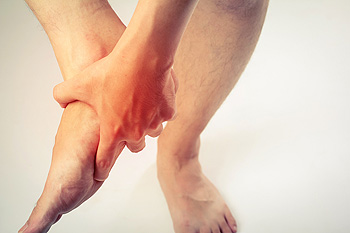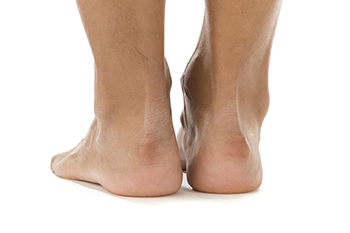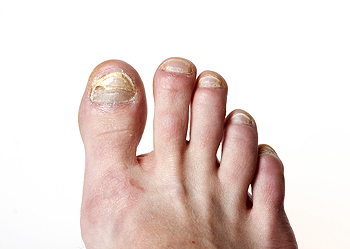Connect With Us
Blog
Items filtered by date: June 2022
What Is Plantar Fibromatosis?

Plantar fibromatosis is a fancy word for having a lump under the skin on the sole of your foot, usually right beneath the arch. The growth, called a fibroma or nodule, can be an inch in diameter. You may have one nodule or a cluster of nodules, which are considered to be benign. However, after a period of time plantar fibromatosis may begin to cause foot arch pain when you are standing and stiffness in the toes. Causes of plantar fibromatosis include heredity, long-term alcohol consumption, and repetitive foot trauma. Certain medical conditions, such as diabetes, liver disease, and epilepsy are believed to put you at further risk for developing plantar fibromatosis. In general, it is more common among men than women. A podiatrist can perform an MRI to determine the severity of the fibroma and offer a variety of treatment options. Among them are corticosteroid injections, custom orthotics, and surgery.
Foot Pain
Foot pain can be extremely painful and debilitating. If you have a foot pain, consult with Philip K. Schrumpf, DPM from Active Feet Clinic. Our doctor will assess your condition and provide you with quality foot and ankle treatment.
Causes
Foot pain is a very broad condition that could be caused by one or more ailments. The most common include:
- Bunions
- Hammertoes
- Plantar Fasciitis
- Bone Spurs
- Corns
- Tarsal Tunnel Syndrome
- Ingrown Toenails
- Arthritis (such as Gout, Rheumatoid, and Osteoarthritis)
- Flat Feet
- Injury (from stress fractures, broken toe, foot, ankle, Achilles tendon ruptures, and sprains)
- And more
Diagnosis
To figure out the cause of foot pain, podiatrists utilize several different methods. This can range from simple visual inspections and sensation tests to X-rays and MRI scans. Prior medical history, family medical history, and any recent physical traumatic events will all be taken into consideration for a proper diagnosis.
Treatment
Treatment depends upon the cause of the foot pain. Whether it is resting, staying off the foot, or having surgery; podiatrists have a number of treatment options available for foot pain.
If you have any questions, please feel free to contact our office located in Missoula, MT . We offer the newest diagnostic and treatment technologies for all your foot care needs.
What Is This Painful Bump at the Back of My Heel?

The Achilles tendon attaches the calf muscle to the heel bone at the back of the foot. Some people have heel bones with a more prominent bump at this location. They may also wear tight or stiff shoes, such as high heels, that rub against this area. This combination of a bony prominence in the heel bone and pressure from footwear can squeeze the soft tissue between the heel and the shoe. This can inflame the tissue and cause it to thicken into a bump that further pressurizes the soft tissue and causes pain. This condition is known as Haglund’s deformity, or “pump bump.” Having very high arches or a tight Achilles tendon can also increase a person’s risk for developing Haglund’s deformity. Symptoms may include a visible bump, redness, swelling, and pain at the back of the heel, especially when wearing certain shoes. A podiatrist can reduce symptoms of Haglund’s deformity with a variety of conservative treatments and therapies. Reach out to a podiatrist if you are experiencing any of the symptoms discussed here to get the relief you deserve.
Many people suffer from bouts of heel pain. For more information, contact Philip K. Schrumpf, DPM of Active Feet Clinic. Our doctor can provide the care you need to keep you pain-free and on your feet.
Causes of Heel Pain
Heel pain is often associated with plantar fasciitis. The plantar fascia is a band of tissues that extends along the bottom of the foot. A rip or tear in this ligament can cause inflammation of the tissue.
Achilles tendonitis is another cause of heel pain. Inflammation of the Achilles tendon will cause pain from fractures and muscle tearing. Lack of flexibility is also another symptom.
Heel spurs are another cause of pain. When the tissues of the plantar fascia undergo a great deal of stress, it can lead to ligament separation from the heel bone, causing heel spurs.
Why Might Heel Pain Occur?
- Wearing ill-fitting shoes
- Wearing non-supportive shoes
- Weight change
- Excessive running
Treatments
Heel pain should be treated as soon as possible for immediate results. Keeping your feet in a stress-free environment will help. If you suffer from Achilles tendonitis or plantar fasciitis, applying ice will reduce the swelling. Stretching before an exercise like running will help the muscles. Using all these tips will help make heel pain a condition of the past.
If you have any questions please contact our office located in Missoula, MT . We offer the newest diagnostic and treatment technologies for all your foot and ankle needs.
Healing From a Broken Ankle

A broken or fractured ankle happens when there is a partial or complete break in the ankle joint bones – the tibia, the fibula, and the talus bones. This can occur from excessive stress on the joint through heavy impact or twisting beyond the normal range of movement. The main symptom of a broken ankle is pain but swelling and bruising can also show at or around the site of the break. The ankle joint may be stiff and hard to move, and it might be hard for one with such a fracture to support their body weight. Recovery from a broken ankle will depend on how severe the break is and how well one follows the recommended care regimen. In most cases, recovery time is six to 12 weeks. If you think you have broken your ankle, visit a podiatrist to find out if there is an actual break and how it can best be treated.
Broken ankles need immediate treatment. If you are seeking treatment, contact Philip K. Schrumpf, DPM from Active Feet Clinic. Our doctor can provide the care you need to keep you pain-free and on your feet.
Broken Ankles
A broken ankle is experienced when a person fractures their tibia or fibula in the lower leg and ankle area. Both of these bones are attached at the bottom of the leg and combine to form what we know to be our ankle.
When a physician is referring to a break of the ankle, he or she is usually referring to a break in the area where the tibia and fibula are joined to create our ankle joint. Ankles are more prone to fractures because the ankle is an area that suffers a lot of pressure and stress. There are some obvious signs when a person experiences a fractured ankle, and the following symptoms may be present.
Symptoms of a Fractured Ankle
- Excessive pain when the area is touched or when any pressure is placed on the ankle
- Swelling around the area
- Bruising of the area
- Area appears to be deformed
If you suspect an ankle fracture, it is recommended to seek treatment as soon as possible. The sooner you have your podiatrist diagnose the fracture, the quicker you’ll be on the way towards recovery.
If you have any questions, please feel free to contact our office located in Missoula, MT . We offer the newest diagnostic and treatment technologies for all your foot care needs.
Arthritis Can Cause Pain in the Feet and Ankles
Ways to Avoid a Toenail Fungal Infection

Getting a toenail infection can be easy, mainly because the fungus that causes it is very contagious. Spotting it is also easy. Infected toenails may change color to white, yellow, brown or green. They may become thickened, raise up off the toe, or crumble. Luckily, a number of simple precautions can help to keep fungal infections at bay. First, protect your feet by wearing shower slippers at pools, public showers, spas or gym locker rooms, all of which are common breeding grounds for fungi. If you have recently had a fungal infection, don’t wear shoes or slippers you wore during that time. Change your socks when they get sweaty. Keep your feet clean and dry, and wear canvas or mesh shoes that allow your feet to breathe. Give your shoes at least 24 hours to dry out before wearing them again. Avoid sharing personal items, such as nail clippers, shoes or towels, that may have picked up a fungus. Keep your feet moisturized, as fungi can enter through cracks or sores in the skin. Finally, be vigilant and check your toenails at least once a month for symptoms. If you need help in dealing with toenail infections, please consult a podiatrist.
If left untreated, toenail fungus may spread to other toenails, skin, or even fingernails. If you suspect you have toenail fungus it is important to seek treatment right away. For more information about treatment, contact Philip K. Schrumpf, DPM of Active Feet Clinic. Our doctor can provide the care you need to keep you pain-free and on your feet.
Symptoms
- Warped or oddly shaped nails
- Yellowish nails
- Loose/separated nail
- Buildup of bits and pieces of nail fragments under the nail
- Brittle, broken, thickened nail
Treatment
If self-care strategies and over-the-counter medications does not help your fungus, your podiatrist may give you a prescription drug instead. Even if you find relief from your toenail fungus symptoms, you may experience a repeat infection in the future.
Prevention
In order to prevent getting toenail fungus in the future, you should always make sure to wash your feet with soap and water. After washing, it is important to dry your feet thoroughly especially in between the toes. When trimming your toenails, be sure to trim straight across instead of in a rounded shape. It is crucial not to cover up discolored nails with nail polish because that will prevent your nail from being able to “breathe”.
In some cases, surgical procedure may be needed to remove the toenail fungus. Consult with your podiatrist about the best treatment options for your case of toenail fungus.
If you have any questions, please feel free to contact our office located in Missoula, MT . We offer the newest diagnostic and treatment technologies for all your foot care needs.
Blog Archives
- August 2024
- July 2024
- June 2024
- May 2024
- April 2024
- March 2024
- February 2024
- January 2024
- December 2023
- November 2023
- October 2023
- September 2023
- August 2023
- July 2023
- June 2023
- May 2023
- April 2023
- March 2023
- February 2023
- January 2023
- December 2022
- November 2022
- October 2022
- September 2022
- August 2022
- July 2022
- June 2022
- May 2022
- April 2022
- March 2022
- February 2022
- January 2022
- December 2021
- November 2021
- October 2021
- September 2021
- August 2021
- July 2021
- June 2021
- May 2021
- April 2021
- March 2021
- February 2021
- January 2021
- December 2020
- November 2020
- October 2020
- September 2020
- August 2020
- July 2020
- June 2020
- May 2020
- April 2020
- March 2020
- February 2020
- January 2020
- December 2019
- November 2019
- October 2019
- September 2019
- August 2019
- July 2019
- June 2019
- May 2019
- April 2019
- March 2019

